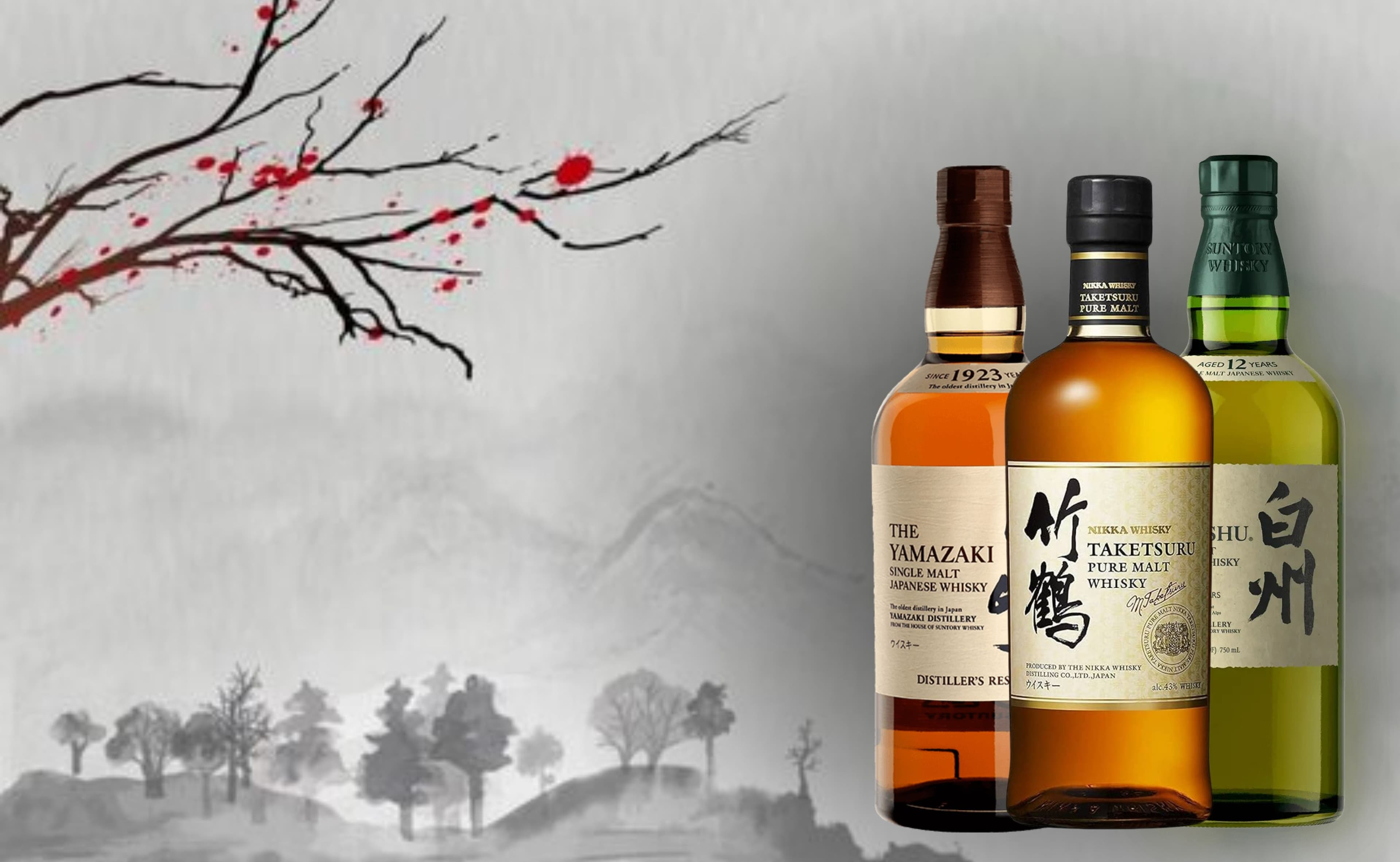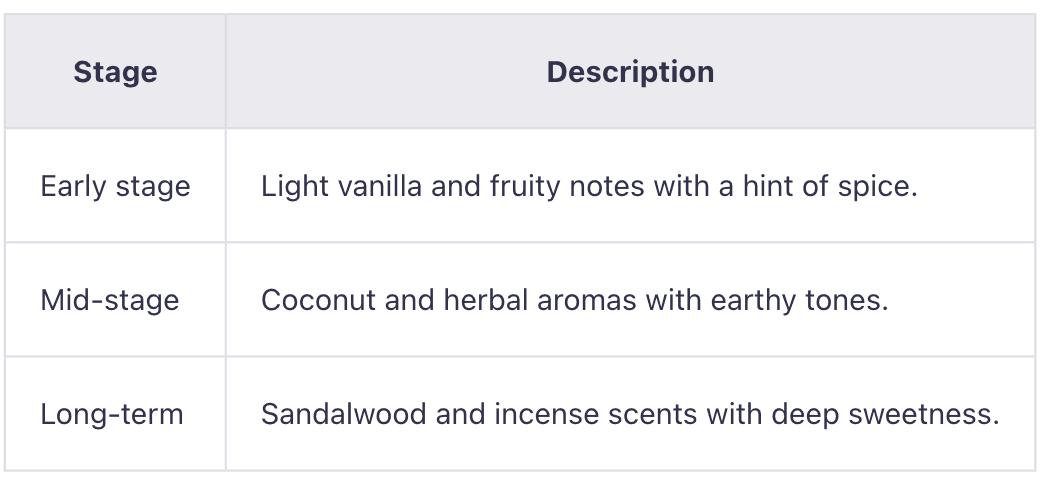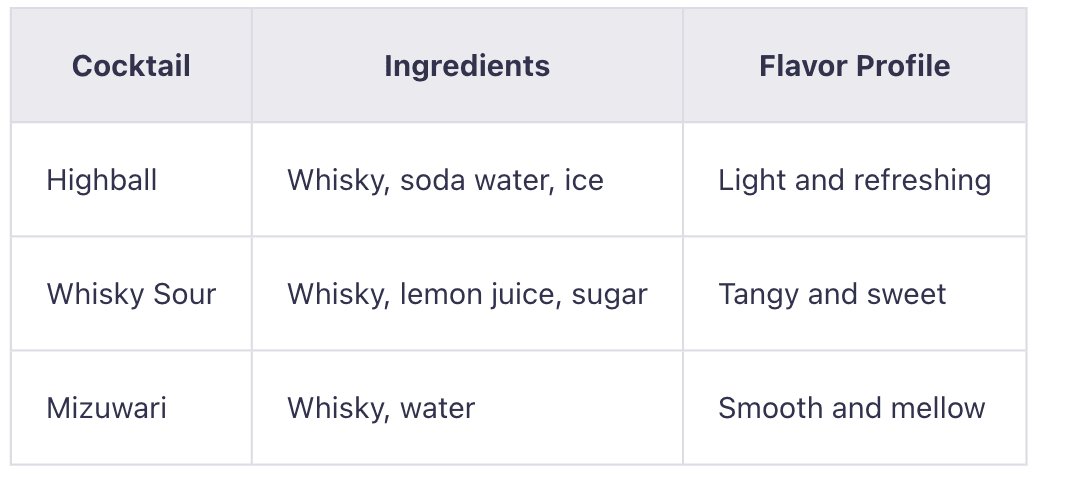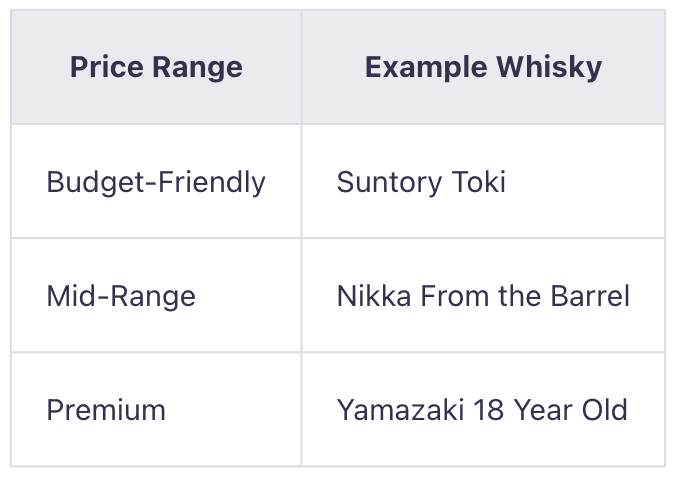05.06.2025
Uncovering The Wonderful World Of Japanese Whisky Distilleries & Brands

Uncovering The Wonderful World Of Japanese Whisky Distilleries & Brands
Japanese whisky is loved by people all over the world. Its popularity keeps growing—exports have gone up by over 70% since 2017, and between 2009 and 2015, they increased an amazing 500%. Why is it so special? It’s because every bottle is made with great care. To be called "Japanese whisky," it must follow strict rules: it must be fermented, distilled, aged, and bottled in Japan. Makers use local things like malt, grains, and water. The whisky is aged in wooden barrels for at least three years.
Did you know Japanese distillers often use Mizunara oak barrels? These rare barrels add a sweet, warm flavor, making each sip special.
This careful process, along with Japan’s humid weather, gives the whisky a smooth and unique taste.
Key Takeaways
-
Japanese whisky is special because of strict rules for making it. Aging in Mizunara oak barrels gives it unique flavors.
-
Japanese whisky started in 1853 and grew a lot. Important people like Masataka Taketsuru helped make it popular.
-
Try Japanese whisky in different ways, like plain, with ice, or as a Highball, to find what you like best.
-
Visiting places like Yamazaki or Nikka distilleries lets you learn how whisky is made and taste amazing drinks.
-
Japanese whisky has many flavors, so it’s great for new and experienced drinkers.
The History of Japanese Whisky
The Origins of Japanese Whisky
Have you ever thought about how whisky came to Japan? It began in 1853 when Commodore Matthew Perry brought Western goods, including whisky, to Japan. At first, whisky was just something new and rare. Over time, it became more than a foreign drink. By the early 1900s, Japan was ready to make its own whisky, inspired by Scotland’s traditions.
In 1923, Shinjiro Torii, the founder of Suntory, took a big step. He built the Yamazaki Distillery near Kyoto, starting Japanese whisky production. Torii picked this spot because of its clean water and special weather. His idea helped create what would later become a worldwide success.
Fun Fact: The Yamazaki Distillery is still running today and is known as the birthplace of Japanese whisky.
Masataka Taketsuru: The Father of Japanese Whisky
If you enjoy Japanese whisky, you should thank Masataka Taketsuru. He is called the "Father of Japanese Whisky" for good reason. In 1918, Taketsuru went to Scotland to learn how to make whisky. He studied everything about it and worked at Scottish distilleries to improve his skills.
When he came back to Japan, he brought more than knowledge. He brought a dream to make real whisky in Japan. Taketsuru worked with Shinjiro Torii to start the Yamazaki Distillery in 1923. Later, in 1934, he started his own company, Nikka Whisky, and built the Yoichi Distillery in Hokkaido. His hard work and love for quality shaped Japanese whisky into what it is today.
Note: Taketsuru faced tough challenges, like Japan’s strict tax rules, which made aging whisky hard. His fight to change these rules helped the industry grow.
Key Milestones in Japanese Whisky History
Japanese whisky has grown a lot since it started. Here are some important moments in its history:
-
1853: Commodore Matthew Perry introduces whisky to Japan.
-
1923: The Yamazaki Distillery becomes Japan’s first whisky distillery.
-
1929: Suntory makes Shirofuda White Label, Japan’s first real whisky.
-
1934: Masataka Taketsuru starts Nikka Whisky and the Yoichi Distillery.
-
1937: Suntory’s Kakubin whisky becomes very popular.
-
1964: The Coffey still changes how whisky is made.
-
1980: Suntory sells 12.4 million cases of its "Old" whisky.
-
2000s: Japanese whisky becomes famous worldwide, with Yamazaki Sherry Cask winning "Best Whisky in the World" in 2013.
Today, Japan has 59 whisky distilleries, with more being built. In 2023, the global market for Japanese whisky was worth $885.6 million and is expected to grow even more. This amazing journey shows how Japanese whisky went from a small craft to a global favorite.
Tip: Want to learn more about Japanese whisky? Visit a distillery like Yamazaki or Nikka to see its history up close.
Unique Characteristics of Japanese Whisky
Distillation Techniques and Japanese Craftsmanship
Japanese whisky is special because of its careful making process. Distillers use copper pot stills to distill the whisky twice. This makes the drink purer and smoother than many others.
Another important step is slow fermentation. By taking more time, distillers bring out richer flavors and smells. This extra care makes every sip feel like a work of art.
Blending is where the magic happens. Experts mix whiskies from different barrels to create balanced and unique flavors. This skill is why brands like Suntory and Nikka are known worldwide for their amazing whiskies.
Tip: Want to taste the craftsmanship? Try a single malt whisky from Yamazaki or Nikka. You’ll taste the care in every drop.
The Role of Mizunara Oak in Flavor Development
Mizunara oak is very important in Japanese whisky. This special Japanese wood gives flavors you can’t find anywhere else. At first, whisky aged in Mizunara barrels tastes like vanilla and fruits. Over time, it develops herbal, coconut, and sandalwood notes.
Mizunara’s loose fibers let the whisky soak deep into the wood. This creates rich and complex flavors as it ages. The result is a whisky that feels warm and full of Japan’s natural beauty.

Note: Mizunara barrels are rare and costly, making these whiskies extra special. If you get a chance to try one, don’t miss it!
Signature Flavor Profiles of Japanese Whisky
Japanese whisky has many flavors, from light and floral to smoky and bold. The country’s weather helps create these unique tastes. Hot summers and cold winters speed up aging, making the whisky interact more with the wood.
Whiskies from Hokkaido often have strong, smoky flavors. Kyoto whiskies are usually lighter and softer. This variety means there’s a Japanese whisky for everyone.
Here’s a quick look at popular types:
-
Blended Whisky: Mixes whiskies from different places for a smooth taste.
-
Single Malt Whisky: Made at one distillery with barley and water, offering a pure flavor.

Japanese whisky often tastes like honey, citrus, and spices. It finishes smoothly, making it different from Scotch or Irish whiskies.
Callout: Whether you like light or bold flavors, Japanese whisky has something to delight your taste buds.
Top Japanese Whisky Distilleries and Brands
Suntory: The Pioneer of Japanese Whisky
Suntory was the first big name in Japanese whisky. It all started in 1923 when Shinjiro Torii built the Yamazaki Distillery. This was Japan’s first malt whisky distillery. Torii wanted to make a whisky that matched Japan’s weather and culture. His hard work created Suntory’s strong reputation.
Today, Suntory is a leader in the whisky world. Its famous brands, like Yamazaki and Hibiki, are loved everywhere. These whiskies show Suntory’s skill in blending and aging. Some key moments in Suntory’s history include:
-
The Yamazaki Distillery began making whisky in 1923.
-
Shinjiro Torii’s idea of a Japanese-style whisky changed the industry.
Tip: New to Japanese whisky? Try Suntory’s Hibiki Harmony. It’s smooth and easy to enjoy.
Nikka: A Legacy of Excellence
Nikka Whisky was created by Masataka Taketsuru, known as the "Father of Japanese Whisky." He learned whisky-making in Scotland and brought his dream back to Japan. In 1934, he started Nikka and built the Yoichi Distillery in Hokkaido. This area is famous for its cool weather and clean water.
Nikka’s whiskies, like Taketsuru Pure Malt and Yoichi Single Malt, are known for their rich and bold flavors. Nikka makes both single malts and blended whiskies, showing its wide range of skills.
Callout: Nikka whiskies often have smoky and peaty flavors. If you like Scotch, you’ll enjoy Nikka.
Chichibu: Innovation in Japanese Whisky
Chichibu Distillery is leading the way for modern Japanese whisky. It was started in** 2008** by Ichiro Akuto and quickly became well-known. Chichibu’s whiskies, like Ichiro’s Malt and Chichibu On The Way, are loved by whisky fans around the world.
The distillery makes small batches using both old and new methods. Its focus on quality and creativity makes it stand out. Chichibu whiskies often mix fruity, herbal, and spicy flavors.
Note: Want to try something different? Ichiro’s Malt is bold and exciting, perfect for whisky lovers.
Other Notable Japanese Distilleries and Boutique Brands
While big names like Suntory, Nikka, and Chichibu are famous, Japan has many smaller distilleries worth exploring. These producers bring fresh ideas and passion to whisky-making, offering special flavors and experiences.
1. Mars Shinshu Distillery
Mars Shinshu is Japan’s highest distillery, located in the Japanese Alps. It uses clean mountain water and cool air, ideal for making whisky. Mars creates single malts and blends, like Komagatake and Iwai Tradition. Their whiskies often taste fruity and nutty, great for beginners.
2. Hakushu Distillery
Hakushu, owned by Suntory, is surrounded by green forests and clear streams. Its whiskies are light and herbal with a touch of smoke. If you like crisp and refreshing drinks, try Hakushu Single Malt.
3. White Oak Distillery
White Oak, in Hyogo Prefecture, is one of Japan’s oldest distilleries. It makes the Akashi whiskies, known for their smooth and balanced flavors. These whiskies are perfect for sipping or mixing in cocktails.
4. Boutique Brands
Smaller brands like Kanosuke and Shizuoka are gaining attention for their creativity. Kanosuke tries different cask types, while Shizuoka uses old-style wood-fired stills. These brands are great for whisky fans who love to try new things.
Tip: Look out for special releases from these distilleries. They often have rare and exciting flavors.
Visiting these distilleries and trying their whiskies will help you enjoy Japanese whisky even more. Each one has its own story and unique taste.
How to Enjoy Japanese Whisky
Serving Styles: Neat, On the Rocks, or Highball
How you serve whisky can change the way it tastes. Japanese whisky is versatile, so you can enjoy it in different ways. If you like bold flavors, try it neat. Pour the whisky into a glass and sip it slowly to enjoy its natural taste.
Prefer something cooler? Serve it on the rocks. The ice chills the whisky and softens its flavors. This style is perfect for a warm evening.
For a refreshing twist, make a Highball. Mix whisky with soda water and add ice. This light and fizzy drink is a favorite in Japan. It’s easy to make and pairs well with meals.
Tip: Experiment with these styles to find your favorite. Each one offers a unique experience.
Tasting Tips for Beginners and Experts
Tasting whisky is an art, but it’s also fun. Start by looking at the color. A clear glass helps you see its golden hues. Next, swirl the whisky gently and take a sniff. The aroma tells you a lot about its flavors.
Take a small sip and let it coat your palate. Hold it in your mouth for a moment to explore its taste. Notice the finish, or aftertaste, as you swallow. Some whiskies leave a sweet note, while others feel smoky or spicy.
Adding water or ice can change the flavor. Try it both ways to see what you like best. Remember, everyone’s taste is different. Mike Miyamoto, a master distiller, says whisky-making is about "continuous refinement." Your tasting journey can evolve too.
Note: Don’t rush. Take your time to enjoy every step of the process.
Popular Japanese Whisky Cocktails to Try
Japanese whisky shines in cocktails. The Highballis the most popular. It’s light, fizzy, and easy to make. Just mix whisky with soda water and ice.
Another great choice is the Whisky Sour. Combine whisky, lemon juice, and sugar for a tangy drink. For something unique, try a Mizuwari. This classic Japanese cocktail mixes whisky with water in a 1:2 ratio.

Callout: Cocktails are a fun way to enjoy whisky. Try making one at home or order one at a bar.
Experiencing Japanese Whisky Culture
Distillery Tours: Discovering the Craft
Visiting a whisky distillery in Japan is an exciting experience. You can see how skilled makers create some of the world’s best whiskies. At places like Yamazaki or Nikka’s Yoichi Distillery, you’ll learn about every step—from fermenting to aging in Mizunara oak barrels.
Some distilleries offer guided tours with whisky tastings. For example, Shirakawa 1958 whisky is a rare treat. It has a high rating of 9.5/10 and only 1,500 bottles exist. Its history and rarity make it special for whisky fans.
Whisky tourism is becoming very popular. In** 2023**, it was worth $19.8 billion and could double by 2031. This shows how much people enjoy exploring whisky’s culture and craftsmanship.
Tip: Plan your distillery visit early. Famous spots like Yamazaki fill up fast.
Whisky Bars in Japan: Unique Tasting Adventures
Japan’s whisky bars are perfect for trying different whiskies. These cozy places let you taste everything from classic blends to rare single malts. Bars like Bar High Five in Tokyo or Zoetrope are famous for their large collections and expert bartenders.
Many bars serve whisky in creative ways. You can have it neat, with ice, or as a fizzy Highball. Some bars even offer tasting sets so you can compare whiskies side by side.
These bars are more than just places to drink. They’re about meeting others who love whisky too. It’s a great way to share your passion and learn more.
Callout: Ask bartenders for advice. They know the best whiskies to try.
Japanese Whisky Festivals and Events
Want to explore whisky culture more? Go to a Japanese whisky festival. These events celebrate whisky’s history, craft, and future. The 2023 Japanese Whisky Festival honored 100 years of Japanese whisky with tastings, expert talks, and rare bottles.
Special events, like the Yamazaki 55 Year Old tasting in Portland, show how exclusive Japanese whisky can be. Big names like Shinji Fukuyo, Suntory’s Chief Blender, often attend these events.
Whisky festivals are growing in popularity worldwide. Mamoru Tsuchiya, a whisky expert, says these events bring global attention to Japanese whisky.
Note: Watch for upcoming festivals. They’re a fun way to taste and learn about whisky with others.
Japanese whisky is not just a drink; it’s a story of history, skill, and creativity. From Masataka Taketsuru’s vision to Suntory’s innovations, each bottle has meaning. The use of Mizunara oak and bamboo filtration adds unique flavors. Distilleries like Yamazaki, Yoichi, and Chichibu make whiskies inspired by Japan’s beauty and traditions.
Tip: Try special Japanese whiskies like the Kacho Fugetsu series or Hibiki Harmony. These bottles show the care and artistry in every sip.
Whether you tour a distillery, enjoy a Mizuwari, or sip a Highball, Japanese whisky gives a one-of-a-kind experience.
FAQ
What makes Japanese whisky special compared to Scotch or Bourbon?
Japanese whisky is all about balance and care. Makers often use Mizunara oak barrels, which give flavors like sandalwood and spice. Japan’s weather helps whiskies age faster, making them smoother.
Tip: Try a Japanese single malt to taste these unique traits!
Is Japanese whisky good for beginners?
Yes, it’s great for beginners! Japanese whisky has many flavors, from light and floral to smoky and rich. Start with a blended whisky like Hibiki Harmony. It’s smooth and easy to enjoy.
Callout: Don’t stress—just take a sip and enjoy!
How do I store Japanese whisky?
Keep the bottle standing in a cool, dark spot. Avoid sunlight and heat. Once opened, drink it within a year for the best flavor.
Note: Storing it right keeps the whisky tasting great.
Is Japanese whisky expensive?
Some bottles are costly, especially rare ones, but there are affordable choices too. Brands like Suntory and Nikka have whiskies for different budgets.

Can I visit Japanese whisky distilleries?
Yes, you can! Distilleries like Yamazaki and Nikka Yoichi offer tours. You’ll see how whisky is made and try some too. Book early because spots fill up fast.
Tip: Visiting a distillery is a fun way to learn and taste!
About the author

Natalia Alejandrez Muñiz
I'm a whisky enthusiast and a writer in the making. I enjoy exploring new flavors, learning about the history behind each bottle, and sharing what I discover along the way. This blog is my space to grow, connect, and raise a glass with others who love whisky as much as I do.
To the author